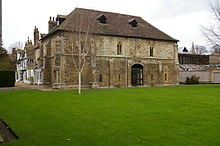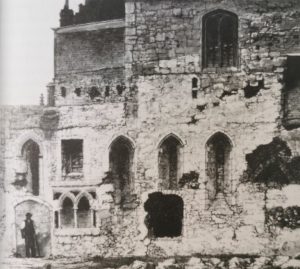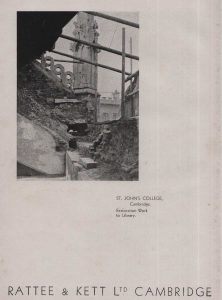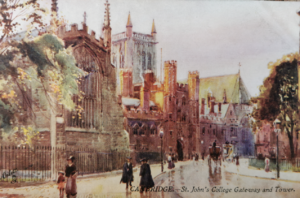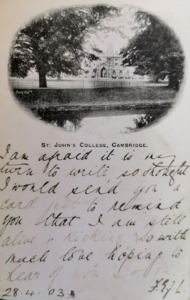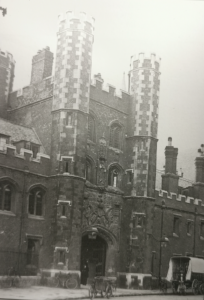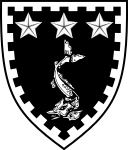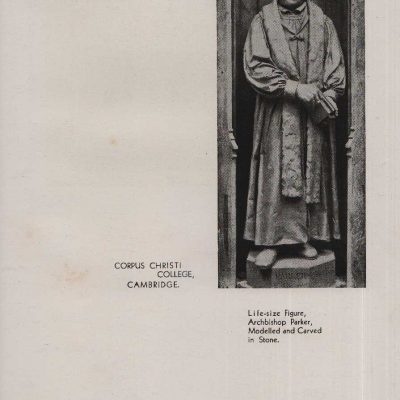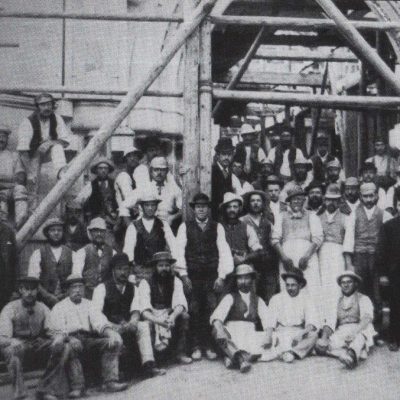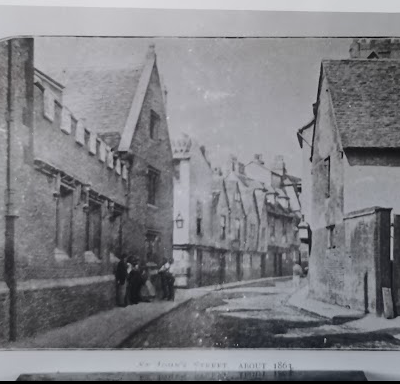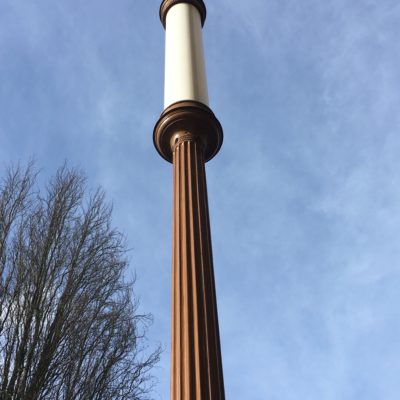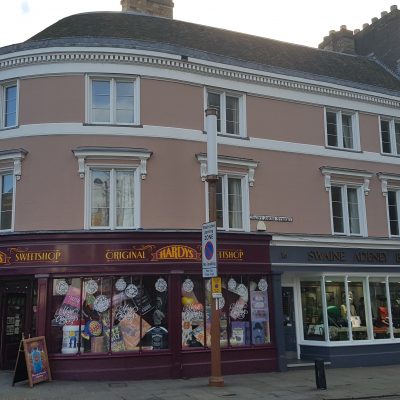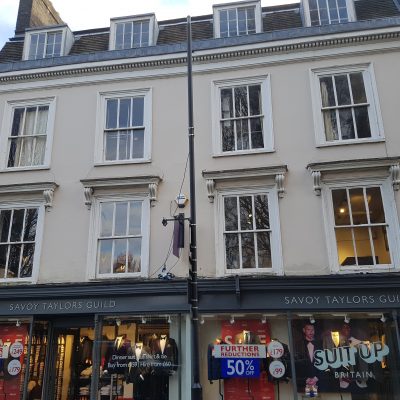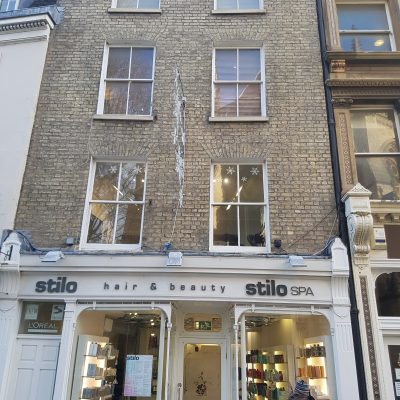Search by topic
- archaeology
- Building of Local Interest
- chapel
- charity
- church
- crime
- dressmaker
- fire
- Great Eastern Railway
- Listed building
- Mapping Relief
- medieval
- oral history
- poverty
- Public House
- Religious House
- Roman
- scholar
- school
- Then and Now
- tudor
- women
- work
- world war one
- world war two
Search by text
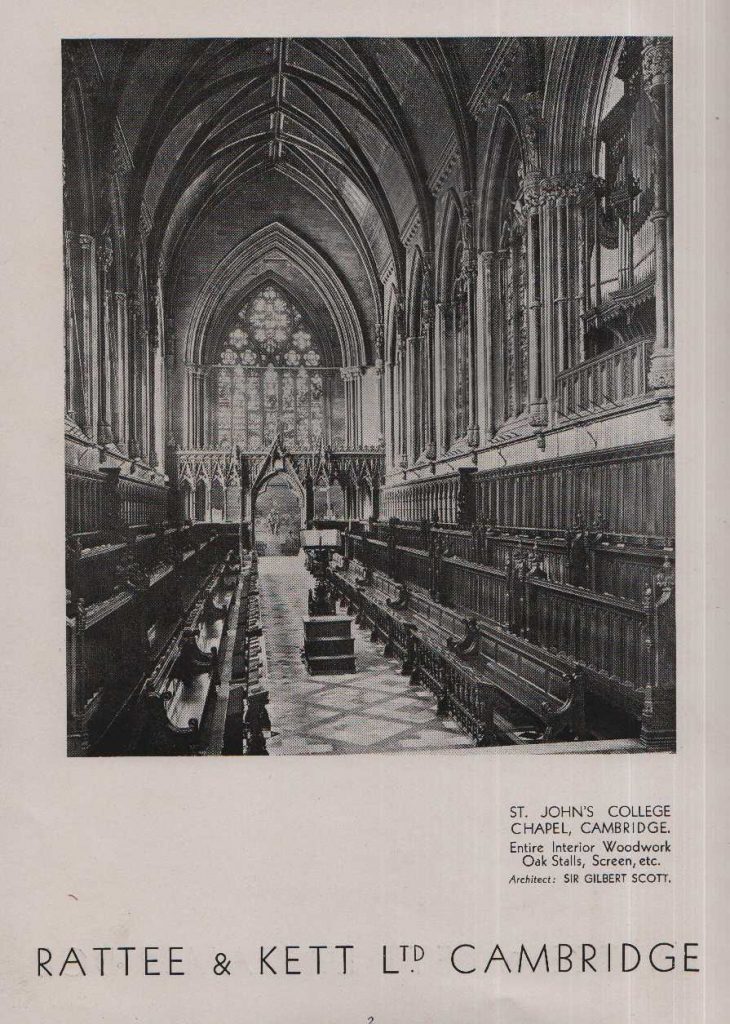
St John’s Hospital / St John’s College
History of St John's College
The main hospital in Cambridge during medieval times was St John’s. It was built on an area of marshy land next to the river. Founded about 1200 it received many large endowments from local people such as the Dunning family. Its purpose was to care for the sick with the exception of pregnant women, lepers, the wounded, paralysed cripples and the insane, who were supposed to go to St Radegund’s, the Leper hospital and St Anthony’s.
Hugh de Balsham, bishop of Ely, used it to provide hostel accommodation for his monks. However, in 1284, the bishop removed the students into hostel on Trumpington Street, the origin of Peterhouse.
The hospital was turned into a college on the initiative of Lade Margaret, mother of Henry VII, in 1511. The chapel survived until 1868 when it was demolished and replaced.
A detailed history of the hospital can be found here:
https://www.british-history.ac.uk/vch/cambs/vol2/pp303-307
General information about St John’s College can be found on Wikipedia.
1694
The Cambridge Ghost Book, Halliday and Murdie, 2000, contains the account of Abraham de la Pryme, who studied at St John’s 1690-1694. Pryme records in his diary of 1694 how he was told in letters that the house opposite St John’s, occupied by Valentine Austin, a painter, was believed to be haunted. Strange noises came from the room where Austin and his wife slept; Austin allowed people to explore his house to try and explain what was happening. After four weeks the situation was worse: loud noises, stones breaking windows and smells. This all attracted spectators and the Rev John Walker of Holy Sepulchre brought several people to pray. The events finally stopped; Isaac Newton thought the whole affair the work of ‘mere cheats and imposters.’ Nothing more is known about the Austins.
1706
Geoff Yeates in ‘ Cambridge College Ghosts’ relates the ghost story connected with Souldern rectory in Oxfordshire. various strange events happened in 1706 that were reported in a pamphlet in London that year. Geoffrey Shaw took up then living at Souldern in 1698, having become a Fellow of St John’s in 1680. Robert Grove, also a Fellow of St John’s visited him in 1706. Shaw recounted to him various strange experiences that had happened to him the previous week involving the apparition of John Naylor, a friend from St John’s who had died in 1701. The spectre of Naylor had told Shaw that their mutual friend Arthur Orchard was about to die suddenly and that Shaw himself would die soon after.
Orchard did indeed die unexpectedly in August 1706 and Shaw died of an accidental fall in November of the same year.
1778
James Wood came to St John’s, son of a Lancashire weaver; he occupied a garret off O Staircase. He was very poor and unable to afford candles sat on the staircase in the glow of a rush light to read. He eventually became a Fellow and then Master of the College. When he died in 1839, he left a large fortune to the college. It is said his ghost can still be seen reading on the staircase.
The School of Pythagoras is the oldest secular building in Cambridge and was constructed around the middle of the 12th century.
Originally called the Stone House, it belonged to the Dunning family. Eustace Dunning occupied it with his wife and three children.
Rattee and Kett constructed (1866-1869) the entire interior of the chapel – woodwork, oak stalls, screen etc. The architect was Sir Gilbert Scott. A more detailed description can be found here:
https://en.wikipedia.org/wiki/St_John’s_College,_Cambridge#College_Chapel
1881
John S Wood, president, 58, clerk in holy orders, b Yorks
John Eyton Bickersteth Mayor, fellow, 56, clerk in holy orders, b Ceylon
Peter H Mason, fellow, 54, clerk in holy orders, b Hants
John W Peiten, fellow, 57, clerk in holy orders, b Middlesex
Henry Mussell, fellow, 58, clerk in holy orders, b India
Philip T Mann, fellow, 40, college lecturer, b Kent
Charles Taylor, fellow, 40, clerk in holy orders, b London
William Emerton Heitland, fellow, 33, college lecturer, b Norfolk
Joseph T Ward, fellow, 27, clerk in holy orders, b Oxon
Donald MacAlister, fellow, 26, demonstrator of physics, b Scotland
Richard E Verdon, fellow, 35, university lecturer, b Lancs
Henry A Mead, MA, 29, university extension lecturer, b Norfolk
John S Hill, BA, 26, student, b Ireland
Daniel W Samways, 24, undergraduate, b Hants
John H Winter, 21, undergraduate, b Northumberland
Robert A H MacFarland, 20, student, b Northern Ireland
William E Cleaver, 22, student, b Middlesex
Francis Woodward Clementson, 18, student, b Staffs
George C Herbert, 18, student, b Salop
Thomas C Ward, 21, student, b Nottingham
Algernon C Clifford, 18, student, b Sea
Arthur J Wells, 20, student, b India
Edward S Chapman, 21, student, b Australia
Dudley E C Falcks, 22, undergraduate, b Middlesex
Frank Hill, 18, undergraduate, b Leics
Jeremiah Cohmaw, 21, undergraduate, b Middlesex
Alleyne Fitzherbert, 21, undergraduate, b Derbysh.
Edward J Mapson, 19, undergraduate, b Somerset
John T Knight, 20, undergraduate, b Northants
Charles S Middlemiss, 21, undergraduate, Yorks
Henry A Thomas, 23, undergraduate, b Wales
Frederick F P Penruddock, undergraduate, b Wilts
Alexander Cameron, visitor, 20, candidate for scholarship, b N Ireland
Nathaniel H Garland, 21, undergraduate, b Derbyshire
Richard B Davies, 20, undergraduate, b Herefordshire
Edward Ackroyd, 20 undergraduate, b Yorkshire
Roger N Goodman, 18, undergraduate, b Cambridge
Harry G Chance, 19, undergraduate, b Gloucestershire
Ernest H Ellison, 20, undergraduate, b Yorks
John H Edwards, 21, undergraduate, b Lancs
John B Ridges, 25, undergraduate, b Staffs
Joseph R Tanner, 20, undergraduate, b Somerset
Alfred c Scott, 19, undergraduate, b Surrey
James Peiris, 21, undergraduate, b Ceylon
James B Whitehead, BA, 23, b Trieste
Leonard T Horne, undergraduate, 20, b Hants
John H Haviland, undergraduate, 21, b Sussex
Hugh L Dawson, undergraduate, 21, b Lancs
Walter M Landers, visitor, 20, b Lancs
Frank W Graham, undergraduate, 20, b Durham
Leonard Wilkinson, undergraduate, 19, b Surrey
Thomas Clarke, 20, undergraduate, b Lancs
Henry E Mills, 20, under gate porter, 33, b Sussex
1891
1901
Joseph Larmor, 43, teacher, b Northern Ireland
Jean Etienne Reenen de Villiers, 26, barrister, b South Africa
Frederick F Blackman, 34, teacher, b London
William H Barker, 21, college porter, b Cambridge
1911
Frederick Frost Blackman, 44, reader in Botany Cambridge University, b London
Charles Gawthrop, 36, college servant gate porter, b Histon
1912
1935
Cambridge Standard 13.9.1935: Last year, when the front of the college was restored the two gateway turrets facing St John’s Street were demolished and rebuilt; now the turrets within the court are being renovated. Restoration work has disclosed old oak panelling.
For life of bedder at St John’s, see Janet Haggar interview.
Contribute
Do you have any information about the people or places in this article? If so, then please let us know using the Contact page or by emailing capturingcambridge@
License
This work is licensed under CC BY-NC-SA 4.0





